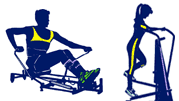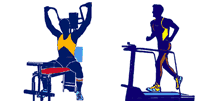|
ALL ABOUT SPEED SENSORS
Virtually all cardiovascular fitness equipment, upright
bikes, recumbent bikes, elliptical cross trainers, steppers, climbers, skiers,
upper body ergometers ( UBE's ), indoor rowers and treadmills have some sort
of speed sensor incorporated into their design. Vintage exercise bikes used
a mechanical "pick up" that was mounted on the flywheel shaft and converted
the turns of the spinning flywheel into rotations of a speedometer cable,
whose rotations were interpreted by a mechanical speedometer. Treadmills
and most other cardio equipment used other methods.
As designs advanced, most exercise bike manufacturers abandoned the mechanical speedometers with their mechanical pick ups. Current cardio equipment utilize a variety of methods to keep track of speed, steps or strides, which calls for different kinds of speed sensors. For the purposes of this discussion, we will use the term "speed sensor" to
mean any sensor that detects speed, steps, strokes or strides.
One commonly employed type of speed sensor is one that
detects a passing magnet. When a piece of cardio equipment has this type
a speed sensor, a strong magnet is mounted on a moving part. In a treadmill,
the moving part could be the pulley on the drive roller. In an exercise bike,
the sprocket is frequently used. An elliptical cross trainer might use a
pedal crank arm or a flywheel. Basically, the magnets can be attached to
any part whose motion changes are directly proportional to the speed that
the cardio equipment is used. The magnets are positioned so that with each
rotation or movement they closely pass the speed sensor, which is basically
a reed switch that is operated by the magnet's proximity. The units electronics
count the operations of the speed sensor and convert them to meaningful displays
on the display panel or console.
Optical sensors are also used by some cardio equipment.
In this set up, a strobe light,, usually infrared, is aimed at a sensor the
beam is either interrupted by a chopper wheel or reflected off patterned
mirrored surfaces. The chopper wheel or the patterned reflective surfaces
are once again attached to moving parts. In both cases, the interruptions
of the light beam are detected by the speed sensor and with each operation
of the sensor a signal is sent to the cardio equipment's electronics to be
counted , interpreted and displayed on the display console.
Some treadmills determine the speed from speed sensors
that are contained inside of the drive motor. In this arrangement, small
current pulses are induced into small coils in the drive motor with each
rotation of the motor. The pulses are passed by a wire connection to the
treadmill's electronics to be processed and displayed just like they are
with the more popular methods of speed detection.
Some cardio equipment that have alternators, mostly
elliptical cross trainer and exercise bikes, pick up the speed pulses directly
from a dedicated terminal on the alternator. From there, the pulses are processed
and displayed in the same manor as in the other cases.
Yet some other cardio equipment utilizes Hall effect
sensors that detect changes in a small current flow as a magnetic field in
the sensor is affected by passing metallic components of the cardio equipment.
Once again, the changes are counted by the cardio equipments electronics,
interpreted and displayed on the console.
The above mentioned types of speed sensor systems cover
99% of all cardio equipment. Each method has good points and bad points and
the cardio equipment manufacturers try to utilize to most reliable, most
economical method for their particular application.
|





